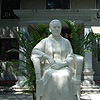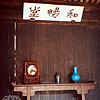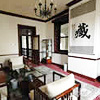On October 10, 1911, the Wuchang Uprising broke out. With one province after another declaring independence from the Qing Dynasty government. As a result, the rule of the Qing Dynasty collapsed, marking an end to the feudal autocratic monarchy of more than 2,000 years and founding the first republic in Chinese history.
To pay tribute to the 100th anniversary of the Chinese Revolution of 1911, with the guidance of Chinese Ministry of Culture, our team designed the photo album which is named "A Century of Change". Through the feature, we will share our insight from our hard work with the readers too.
Soong Ching Ling Memorial Residence in Shanghai
|
 |
Soong Ching Ling was the former vice chairman of the People's Republic of China. She devoted her whole life to defending the republic system and the birth of a new China. Held in high respect to her spirit and great devotion, Chinese people regard her as their national mother and a treasure of China.
Soong Ching Ling Memorial Residence in Shanghai is located at No. 1843 in Huai Hai Zhong Lu. It was built in 1920 and became Soong's house in Shanghai in 1948. Covering an area of 5,178 square yards, the house was a milk-white color, boat shaped, two stories and in a western-style. Surrounded by camphor trees, it presents an atmosphere of elegance and peace. The drawing room, study and dining room are on the first floor with the second floor housing the bedroom, office and the bedroom of her housekeeper, Li Yan'e.
Walking into the house, you will find everything displayed as if they were still living there. In the living room, this great woman met many national leaders and important international guests and discussed state affairs with them. Many of her favorite art works were displayed in the simple but elegant lounge. Walking upstairs, you will see the working environment of Soong Ching Ling in her small office where she once read documents concerning national affairs. The bedroom houses her dowry- a set of cane wooden furniture and above the fireplace, hangs a clock used by her husband Sun Yet-sen, the forerunner of Chinese democratic revolution.
Outside the house, there is a patch of lawn covering an area of 2,631 square yards where Soong Ching Ling once held tea parties to entertain Chinese international friends. Near the house, there is an exhibition hall which displays many precious pictures and relics, reflecting the glorious life of this great woman. In front of the hall stands a marble statue of Soong Ching Ling which portrays her as a kind and decent figure in her fifties to sixties.
Source from travelchinaguide.com
Editor: Shi Liwei
1、The Preparation of the Revolution
In November 1894, Sun Yat-sen setted up the Xingzhonghui in Honolulu. The next year in February, Sun built the headquarters of Xingzhonghui in Hongkong, and put forward the first guiding principle of the China democratic revolution.
2、The Uprising of the Revolution
The incompetent and corrupt rule of the Qing Dynasty caused extreme anger in Chinese people, finally, In June 1911, the Railway Protection Movement in Sichuan became the trigger of the Chinese Revolution of 1911.
3、The Success and Failure
December 1st, the Qing government signed the armistice with the revolutionary army, and the battle was stopped for three days. This truce is a key turning point that marks the revolution army changed the view from armed struggle to the politics of compromise.
4、Historic
The Chinese Revolution of 1911 is a great bourgeois-democratic revolution, which has far-reaching historic in modern Chinese history.




